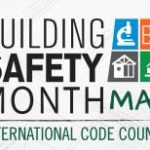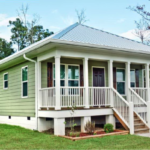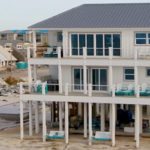We all know that the purpose of a building code is to provide minimum requirements for the health, safety, and welfare of the occupants of buildings built under that code. But what if the owner wants a building that will perform better than the absolute minimum allowed by the code?
There are several “code-plus” programs throughout the country that spell out prescriptive requirements for constructing buildings that are more resistant to local hazards than the code-minimum structure.
One of the more well-known code-plus programs is the “FORTIFIED” series from the Insurance Institute for Business & Home Safety (IBHS). The series consists of three basic programs: FORTIFIED Home, FORTIFIED for Safer Living® (new construction), and FORTIFIED for Safer Business®. The FORTIFIED Home program consists of a set of levels, or tiers of reinforcement, that can be applied to either a new or existing home. Each level builds on the previous level, and they are designated as Bronze, Silver, and Gold level.
For example, with the FORTIFIED Home hurricane requirements, Bronze focuses on making the roof covering wind- and water-resistant, Silver involves preventing failure of openings, strengthening gable ends, and improving anchorage of porches or carports. A Gold designation requires a complete load path from roof to foundation, that chimneys be anchored to the structure, and that critical elements of the building envelope are designed to resist all design pressures.
Video: IBHS Research Center: Wind Test Highlights 2010
FORTIFIED for Safer Living® is a more involved program for new construction only. This program specifies code-plus guidelines for both the structure and the landscaping. These guidelines are designed to provide resistance to the catastrophic-type hazards that exist at the specific locale of the structure. These hazards could include hurricanes, high winds, tornadoes, hail, earthquakes, or severe winter weather. Additional guidelines are meant to help decrease non-catastrophic losses including internal fire, water damage, burglary, and electrical surges.
The FORTIFIED for Safer Business® program is similar to FORTIFIED for Safer Living®, but is applicable to light commercial and multifamily structures.
Video: IBHS Research Center: Commercial Wind Test – Wall Failure
At the heart of these programs is verification that the required features are present in the structure. For FORTIFIED Home, inspection and verification by an approved inspector is required. With the other two programs, plans must be approved prior to construction, in addition to inspections during construction. As IBHS Manager of FORTIFIED Programs Fred Malik says, “You get what you inspect, not what you expect.” Get more information on the FORTIFIED series here.
Another code-plus program that has been around a while is the Federal Alliance for Safe Homes (FLASH) Blueprint for Safety® program. Blueprint for Safety® is an education-based program aimed at residential builders and homeowners, with the mission of providing these groups current and reliable information on how to make homes more disaster-resistant. The primary tool for the builder is the Blueprint for Safety Field Manual, which provides prescriptive details for wind-resistant construction based on 140 MPH windspeed (using ASCE 7-05).
Tools for homeowners include a series of animated how-to’s covering a broad range of hazard-resistant material, and a list of questions to ask your contractor. The animations on wind resistance educate homeowners on window and door protection, foundations, wall construction, strapping, roof types, roof systems, evaluating opening protection systems, and performing a DIY wind inspection on your house. Other videos include wildfire protection, hail protection, flood protection, and how to identify code-approved products. For more information on the program, visit www.blueprintforsafety.org.
A somewhat different code-plus program has recently been developed by the State of Georgia. Under a grant from the U.S. Department of Housing and Urban Development (HUD), a pair of disaster-resistant building codes has been developed. One is an appendix to the IBC(R), and the other is an appendix to the IRC(R). The appendices contain provisions to increase the resistance of structures to hurricane, tornado, and flood disasters. These appendices are being adopted as an optional part of the Georgia State Minimum Standard Codes and will be available for adoption beginning January 1, 2013. As optional appendices, local jurisdictions can choose to adopt all or some of the provisions through a local ordinance.
For example, the Residential Code Appendix R flood provisions provide jurisdictions with an option to either adopt flood elevations of one, two, or three feet higher than the minimum base flood elevation. Similarly, the Appendix R wind provisions contain requirements for building design to resist 100, 110, 120, or 130 MPH winds, with the chosen windspeed option being at least 10 MPH greater than the locally mapped windspeed.
The Georgia IRC Appendix also contains standards for use when residential storm shelters and safe rooms are constructed. A series of workshops are planned by the Georgia Department of Community Affairs to explain and publicize the Appendices. For more information, visit www.dca.state.ga.us/.
Following the tornado outbreaks of 2011, Simpson Strong-Tie developed its own set of code-plus recommendations to increase the tornado resistance of wood-framed dwellings. The IRC minimum requirement for construction using prescriptive fastening with only nails appears problematic. Providing a complete load path with structural connectors at joints in the framing greatly increases the resistance to uplift loads. A prescriptive uplift load path was developed for three different tornado rating scales, EF0 (85 MPH winds), EF1 (110 MPH winds), and EF2 (135 MPH winds). It is estimated that 95% of U.S. tornadoes have windspeeds of EF2 or less; use of these guidelines would provide better performance in most tornadoes, and even homes on the edge of tornadoes rated higher than EF2. These recommendations can be found in the Strengthening Dwellings in Tornado-Prone Areas Technical Bulletin.
– Paul (and Randy)
What are your thoughts? Visit the blog and leave a comment!







Dr. Doug Porter reminded me often that the model building codes are minimum standards, with the emphasis on “minimum.” He lamented that once a minimum code is adopted, engineers too often design to the minimum.
Thank you for providing such valuable information.
As an employee of an IBHS Certified Engineer in the Houston-Galveston Area of Texas, I have found that the Code+ programs are regularly becoming the ‘norm’ in hazard areas. The State of Texas, for example, has IRC/IBC amendments that increase the requirements for structures in its Coastal areas. If owners want (or need) to be able to participate in State Insurance programs they must meet the additional requirements. Many people think these Code+ programs are interchangeable too…they are not. Miami-Dade & TDI are two entirely different codes.